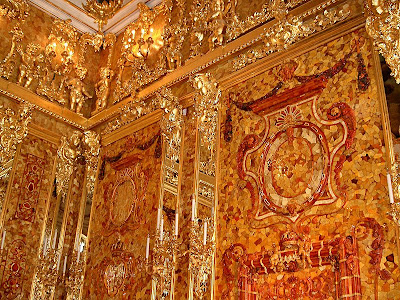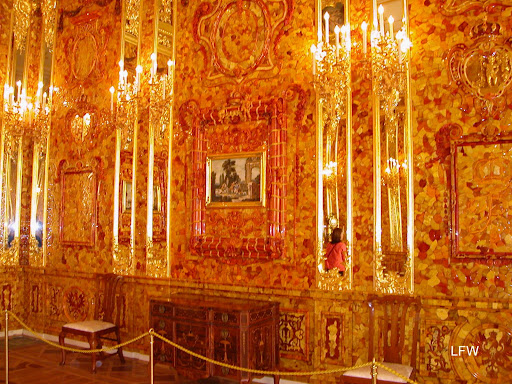| Main » Articles » About Baltic Amber |
Amber room
| Much has been written about the elusive Amber Room, but the mystery remains. The Amber Room's seizure and subsequent disappearance at the close of WW II is arguably the greatest jewel heist ever pulled off- if only on the grounds the chamber  itself was the world's biggest jewelry box, turned
inside out. Whether or not it somehow yet survives to rise again like
raw amber churned up in a storm-tossed sea remains unanswered still.
Conspiracy theories abound. The untimely demise of some prominent Amber
Room hunters plus the many divers who died exploring the unmapped maze
of underground sluices looming below Kaliningrad, flooded by
panic-stricken fascists during the final bombardment, only spark
speculation the Room is further shadowed by a curse.
The estimated value of the Amber Room at today's prices fluctuates
wildly: 142 million USD, 250 million USD, 120 million pounds sterling.
But there may be no real way to measure its worth. Like nesting
Matryoshko dolls, the Room hails from a lost prehistoric world neatly
tucked inside still another lost world.
About 45 million years ago, subtropical trees from the mountainous
region known as the amber forest (long extinct, known collectively as
Pinus Succinifera) underwent drastic climate change, became stressed and
began to weep copious amounts of resin. Sometimes in the form of whole
trunks, they were next borne out to sea by rivers.
Over eons, these oozings became the translucent material known as amber,
one of three known gems of vegetative origin (others are jet, coral and
diamond). Lightest, softest, most fragile of all gems, amber was one of
the first commercial products used for trade and the oldest form of
jewelry. Amber has a long and illustrious history as a coveted luxury
item. The Amber Route is a well-documented European trade equivalent to
China's Silk Road, one punctuated by gallows.
Once a tiny piece of amber was worth the life of a slave. Amber graced
the bridles of wild and wildly wronged beasts for Rome's pleasure, was
found in the tombs of Pharaohs and burned as the richest incense as a
gesture of opulence by Chinese emperors. Long has amber been revered as
magical, medicinal, sacred, a healing stone, a vessel of eternal life
and above all-beautiful.
Today one may purchase a perfectly lovely Baltic amber pendant for the
cost of a fine meal, an affordable luxury. How can we possibly calculate
the worth of the original Amber Room, in which over six tons of choice
Baltic amber was deployed using lost methods? We no longer attempt to
create objects of beauty on this order, our architecture is the poorest
echo of what once was, a collection of mere glass, steel and angles.
Perhaps the only equivalent we can offer to these ancient flights of
fancy, these nearly obscene delights so often executed at the ruination
of the poor to the delight of the noble, is the space shuttle-our modern
answer to the Pyramids, the ruined castles, the Cambodian temples of
Angkor-Wat. But even the space programs have a sort of utility most
foreign to the aesthetic excesses of Emperors and Empresses alike. Or
maybe it is in Hollywood then, where we find our answer� A place in
which lovingly created, lavish worlds impossible to realize in physical
reality take root and burn in the human heart and human eye.
Of the Amber Room, Theophile Gautier wrote in the 1860s: itself was the world's biggest jewelry box, turned
inside out. Whether or not it somehow yet survives to rise again like
raw amber churned up in a storm-tossed sea remains unanswered still.
Conspiracy theories abound. The untimely demise of some prominent Amber
Room hunters plus the many divers who died exploring the unmapped maze
of underground sluices looming below Kaliningrad, flooded by
panic-stricken fascists during the final bombardment, only spark
speculation the Room is further shadowed by a curse.
The estimated value of the Amber Room at today's prices fluctuates
wildly: 142 million USD, 250 million USD, 120 million pounds sterling.
But there may be no real way to measure its worth. Like nesting
Matryoshko dolls, the Room hails from a lost prehistoric world neatly
tucked inside still another lost world.
About 45 million years ago, subtropical trees from the mountainous
region known as the amber forest (long extinct, known collectively as
Pinus Succinifera) underwent drastic climate change, became stressed and
began to weep copious amounts of resin. Sometimes in the form of whole
trunks, they were next borne out to sea by rivers.
Over eons, these oozings became the translucent material known as amber,
one of three known gems of vegetative origin (others are jet, coral and
diamond). Lightest, softest, most fragile of all gems, amber was one of
the first commercial products used for trade and the oldest form of
jewelry. Amber has a long and illustrious history as a coveted luxury
item. The Amber Route is a well-documented European trade equivalent to
China's Silk Road, one punctuated by gallows.
Once a tiny piece of amber was worth the life of a slave. Amber graced
the bridles of wild and wildly wronged beasts for Rome's pleasure, was
found in the tombs of Pharaohs and burned as the richest incense as a
gesture of opulence by Chinese emperors. Long has amber been revered as
magical, medicinal, sacred, a healing stone, a vessel of eternal life
and above all-beautiful.
Today one may purchase a perfectly lovely Baltic amber pendant for the
cost of a fine meal, an affordable luxury. How can we possibly calculate
the worth of the original Amber Room, in which over six tons of choice
Baltic amber was deployed using lost methods? We no longer attempt to
create objects of beauty on this order, our architecture is the poorest
echo of what once was, a collection of mere glass, steel and angles.
Perhaps the only equivalent we can offer to these ancient flights of
fancy, these nearly obscene delights so often executed at the ruination
of the poor to the delight of the noble, is the space shuttle-our modern
answer to the Pyramids, the ruined castles, the Cambodian temples of
Angkor-Wat. But even the space programs have a sort of utility most
foreign to the aesthetic excesses of Emperors and Empresses alike. Or
maybe it is in Hollywood then, where we find our answer� A place in
which lovingly created, lavish worlds impossible to realize in physical
reality take root and burn in the human heart and human eye.
Of the Amber Room, Theophile Gautier wrote in the 1860s: 'Only in
The Thousand and One Nights -and in magic fairy tales, where the
architecture of palaces Is trusted to magicians, spirits and genies, one
can read about rooms made of diamonds, rubies, jacinth and other jewels
used for jewelry- the expression 'The Amber Room' Is not just a poetic
hyperbole, but exact reality. The eye which has not adapted to seeing
this material, applied in such scale, is amazed and is blinded by the
wealth and warmth of tints, representing all colours [in the] spectrum
of yellow - from smoky topaz up to a light lemon. The gold of carvings
seems dim and false in this neighborhood, especially when the sun falls
on the walls and runs thru transparent veins, as though sliding... ' 'Only in
The Thousand and One Nights -and in magic fairy tales, where the
architecture of palaces Is trusted to magicians, spirits and genies, one
can read about rooms made of diamonds, rubies, jacinth and other jewels
used for jewelry- the expression 'The Amber Room' Is not just a poetic
hyperbole, but exact reality. The eye which has not adapted to seeing
this material, applied in such scale, is amazed and is blinded by the
wealth and warmth of tints, representing all colours [in the] spectrum
of yellow - from smoky topaz up to a light lemon. The gold of carvings
seems dim and false in this neighborhood, especially when the sun falls
on the walls and runs thru transparent veins, as though sliding... 'Subject of perpetual renovation, the Amber Room had as many lives and more shapes than a cat. The story unfolds in as many locations. Prussian King Frederick I sought to have the most impressive work of amber art ever created. His chief architect, Andreas Schluter and Gottfried Woffram, an amber artist based at court in Copenhagen, were commissioned to devise a study for the Great Royal Palace in Berlin, using Baltic amber, never before used for interior decoration on such a monumental scale. Work began in 1701 and continued until 1713, drawing on the King's existing amber stores and the best efforts of the most talented amber masters alive. It was subject to plenty of internal bickering and court intrigue along the way. When the old king died, the Amber Room was almost but not quite complete. When Frederick Wilhelm I came to power he was unmoved by the ambitious and costly project, rumor of which had by then traveled to eager ears in Russia. Dispatched to the Berlin Armoury, it languished for three years. En route to France, Russian Tsar Peter I visited Prussia in 1716, casting an admiring gaze on the masterpiece. He was asked to accept the unusual room as a diplomatic gift in order to cement the always uneasy alliance between the two warlike states. Peter's return present. Fifty-five choice grenadiers (unusually tall soldiers) and a royal cup designed by the Tsar's own hand. A year later, after six weeks and a complex route (Berlin, Koenigsburg, Memel, Riga then St.Petersburg) the chests arrived at the Winter Palace. Unpacked, but left unassembled the panels were eventually deposited into storage in a wing of the Summer Palace known as the Kunstkammer (Peter's Museum of Anthropology and Ethnography). There they lay, largely forgotten, until the 1740's. Then Elizabeth I took the throne. The luminous salon was given yet another home in the new, third Winter Palace, in the audience hall. The dimensions of the allotted space and the panels were off, thus faux amber panels and mirrors were added. Shifting from room to room, it followed the curve of Palace reconstruction, serving as a reception hall for state functions. In 1755 the Tsarina ordered the fragile Room to be hand carried to Catherine Palace in Tsarskoje Selo (Tsar's Village, now Pushkin) under the direction of Italian architect Francesco Rastrelli, a court favorite. The village, traditional summer residence of the Tsars, flowed over 1500 acres, boasted over one hundred buildings, the crowning glory of which remains the magnificent Catherine Palace, the oldest structure in the village. By all accounts entering the room itself was like stepping into a monumental, lit-from-within Fabreg egg. "When the work was finished, in 1770, the room was dazzling," write art historians Konstantin Akinsha and Grigorii Kozlov. "It was illuminated by 565 candles whose light was reflected in the warm gold surface of the amber and sparkled in the mirrors, gilt, and mosaics." Rastrelli, with the help of fellow countryman Aleksander Martelli and expert teams including local peasants specially recruited and trained for the task, presided over massive improvements in the Amber Room. He is credited with creating a highly unique and faithful version of this particular installation of the Room. In 1763, Empress Catherine II ordered the previously painted panels to be replaced with authentic amber ones. During this phase the exotic Florentine mosaics, four masterworks of gem-cutting composed of semi-precious stones such as serpentine and onyx depicting the five senses (sight, sound, scent, taste and touch) -a technique perfected by the Medici family- were added. Also showcased in the chamber were numerous fantastic amber masterworks created independently from far-flung centers of amber production. All told, the Amber Room underwent several changes and improvements in 1833, 1865, and again between 1893 and 1897, and minor repairs performed again as late as the 1920s and 30s. Damage occurred due to fluctuating temperatures, and was repaired. 1941 was slated as a year for a major renovation. However, the dogs of war had already sunk their teeth into Russia's flanks. Early in WWII when evacuations of valuable artworks were already being made from Tsarskoje Selo and drawn further behind the lines, it was deemed the Amber Room was too fragile to endure such a move. Instead it was disguised with cotton and gauze, essentially wallpapered over. The Russians made preparations to secret the panels away to underground vaults in Sverdlovsk, but they were too late. A city born of the singular will of its patron saint, St. Petersburg is made up of over 100 islands and connected by some 340 bridges, spanning more than 60 rivers and canals. No building is allowed to be higher than the Winter Palace, the one-time home of the Amber Room under Peter and Catherine. Less than two and a half months after June 22, 1941, when the Soviet Union was attacked by Nazi Germany, German troops advanced on St. Petersburg, famously laying siege (Blokada) on the city of Leningrad for 900 days. An estimated 675,000 people died from the cold, shelling, starvation and disease, each sadly destined for mass graves later to become stirring war memorials. It is reported that some citizens finally fell to eating their own horses to stay alive, then ate what the horses would have consumed. Yet the city itself never fell. Tsarskoje Selo did, and hard. During the occupation, the Germans, adding insult to injury sent cultural officers to evaluate and seize looted artworks as trophies of war. These were collectively intended for the Fuhrer's planned Museum of World Culture in Berlin had the war gone otherwise. They unmasked the thin disguise of the gloriously bejeweled Room and systematically looted the palace, dismantling the rooms as they went. They spirited the contents away to the then-capitol city of Prussia, Koninsberg (now Kaliningrad, a Russian enclave). As late as April 1945, the Amber Room was known to be mounted as an exhibit in Konigsberg Castle. A historic capitol of world amber production, it stands on large deposits of amber and -blue mud- along the Samland Penninsula. This birthplace of the Amber Room is in fact a historic seat of amber production, originating 90% of the world's Baltic amber output previous to the recent collapse of the main mine as recently as the 1990s. Here, in January 1945 after air raids and a savage ground assault by the Allied forces upon Konigsberg, is where the trail of the Amber Room goes cold... The Amber Room story had all the makings of a great historical detective story: buried treasure, Nazi secrets, Cold War conspiracy theories, secret hiding places and classified files. The Amber Room: The Fate of the World's Greatest Lost Treasure by Adrian Levy (Author), Catherine Scott-Clark (Author) | |
| Views: 4010 | Comments: 1 | Rating: 0.0/0 |
| Total comments: 0 | |

